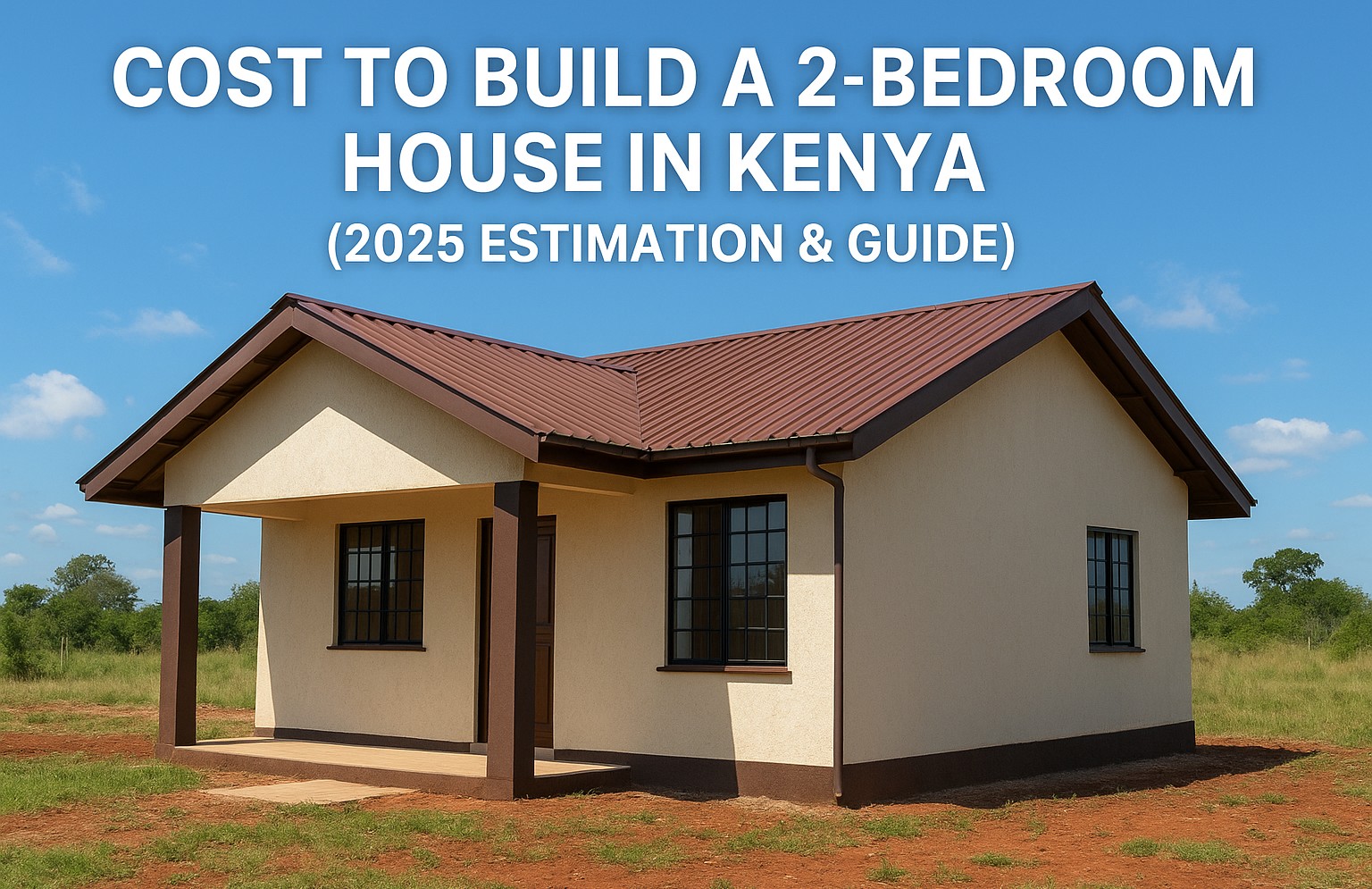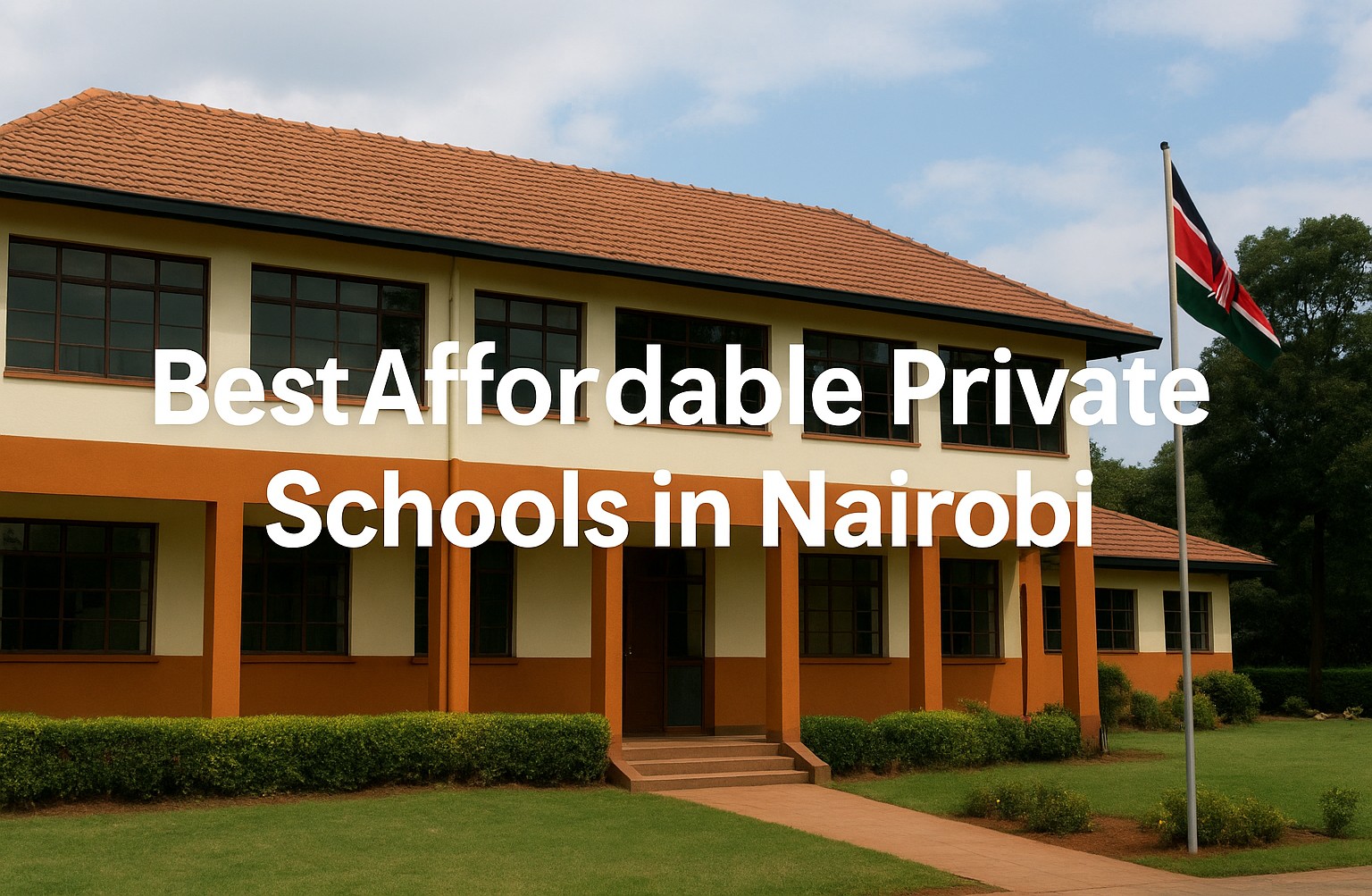

Titus Morebu
Author
Cost to Build a 2-Bedroom House in Kenya (2025 Estimation & Guide)
Discover the realistic cost to build a 2-bedroom house in Kenya in 2025, with region-by-region cost ranges, detailed breakdowns, tips to save, budgeting pitfalls, and pro advice.
🔍 Introduction
Planning to build a 2-bedroom house in Kenya in 2025? This guide gives you a comprehensive, realistic cost projection, plus a clear breakdown of the building process, cost drivers, budgeting tips, and risks to watch. Use this to plan your budget, negotiate with contractors, and avoid surprise costs.
📊 Estimated Cost Range in 2025
The cost to build a 2-bedroom house in Kenya in 2025 depends heavily on size, finish level, region, and site conditions. Based on recent industry rate data, here are general benchmarks:
- Standard finishes, moderate region (e.g. outskirts of Nairobi or in less premium counties): ~ **KES 50,000 to KES 70,000 per m²**
- High-quality finishes or prime locations: up to **KES 90,000 to 100,000+ per m²**
- Smaller, more economical houses (compact layout, basic finishes): the lower end of the range above
For example, using a size of 80 m² (typical for a modest 2-bedroom home), you might expect:
| Finish Type / Quality | Approx. Cost per m² | Total Estimate (80 m²) |
|---|---|---|
| Basic / mid-level finish | KES 55,000 | KES 4,400,000 |
| Good / above average finish | KES 70,000 | KES 5,600,000 |
| High-end finish in premium area | KES 90,000 | KES 7,200,000 |
Some sources report that a 2-bedroom house (80–90 m²) in Kenya in 2025 may cost between **KES 3.9 million and KES 7.56 million**, depending on finishes and location. Others estimate KES 1.8 million to 5 million for more modest builds, though those are likely for simpler finishes or rural sites. Always treat these as ranges, not guarantees.
Industry-wide rate compilations suggest residential construction costs in Kenya in 2025 start at about **KES 54,730 per m²** for standard bungalows in Nairobi and rise to **KES 97,730+ per m²** in premium areas. (These rates reflect typical materials, labour, and finish level for residential works.)
🧱 Key Cost Drivers
The variation in total cost stems from multiple factors. Below are the major levers and how they impact your budget.
1. Location and Accessibility
- Urban vs rural location: Getting materials and labour into remote or difficult-access zones adds transport and logistics costs.
- Soil and site conditions: Rocky ground, poor soil, high water table or steep slopes demand stronger foundations.
- Regulatory costs: County building permits, compliance, and inspection costs vary by county.
2. Size & Layout Efficiency
- Compact layout with fewer corridors saves floor area and finishing costs.
- Height: a single storey costs less per unit floor area than adding mezzanine or split levels.
3. Finishes & Materials Quality
- Flooring (tile, wood, polished concrete), wall finishes, windows, doors, plumbing and sanitaryware have wide quality spans.
- Imported vs local materials: Imported finishing materials quickly inflate cost when freight, duties, and import levies are included.
4. Structural Design & Engineering Complexity
- Number of beams, column spacing, roof structure complexity influence the steel & formwork cost.
- Large spans or cantilevers require more reinforcement and higher structural design intensities.
5. Labor & Contractor Overheads
- Skilled vs unskilled labour mix.
- Contractor markup, supervision, wastage allowances, mobilization costs.
6. Utilities, Services & Infrastructure
- Water connection, septic system or sewer, electrical meter, wiring, drainage and site works.
- Access roads, fencing, gates, landscaping, external works.
7. Contingency & Inflation Buffer
Always allocate **10–15 %** of your estimated cost for unexpected costs—design changes, price escalations, delays, or errors.
🧮 Sample Detailed Cost Breakdown (Hypothetical 80 m² Home)
Below is an illustrative breakdown for a modest 2-bedroom house (80 m²) with average finishes. These proportions will shift depending on finish spec and region.
- Foundation & substructure (earthworks, hardcore, foundation footing): ~ 15 %
- Superstructure (walls, columns, slabs, beams): ~ 25 %
- Roofing (truss, sheets/tiles, insulation, rainwater goods): ~ 10 %
- Windows, doors & glazing: ~ 8 %
- Plastering, screeds & internal walls: ~ 8 %
- Floor finishes & tiling: ~ 8 %
- Electrical, plumbing & sanitary installations: ~ 10 %
- Painting, fixtures & fittings: ~ 6 %
- External works (fencing, paths, landscaping): ~ 5 %
- Contingency & miscellaneous: ~ 5 %
If your total budget is KES 5,000,000, that implies:
- Foundation & substructure: ~ KES 750,000
- Superstructure: ~ KES 1,250,000
- Roofing: ~ KES 500,000
- Windows & doors: ~ KES 400,000
- Finishing works, services, external works, etc. making up the rest
📍 Regional Variations & Examples
Construction cost per m² jumps significantly depending on region:
- Nairobi / Mt. Kenya / Central Kenya: standard bungalows cost ~ KES 54,730 per m², while higher end maisonettes climb higher. In prime zones, you may see 70k+ or more per m².
- Western / Nyanza regions: average residential finish costs run higher in top areas—lux maisonette levels may reach KES 97,730 per m².
- Coastal Kenya: mid-level finishes might fall somewhere between the Nairobi mid range and premium ranges, due to material shipping, humidity adaptations, etc.
In less developed counties or rural areas, you may find lower cost rates if materials & labour are local and basic finishes are used. But for reliable, durable construction, rates closer to the national average are safer to assume.
💡 Tips to Optimize & Control Costs
Here are practical strategies to get the most out of your budget without compromising quality significantly:
- Value engineer early: Optimize the structural layout (fewer beams, standard dimensions) before committing to design.
- Bulk procurement & early ordering: Lock in major materials early to avoid price escalation.
- Mix finishes smartly: Use high-end finishes selectively (e.g. main bedroom) and simpler finishes elsewhere.
- Local materials sourcing: Use quality local suppliers to reduce freight & duty costs.
- Phasing & staging: Complete critical structural and weatherproof works first, do finishes in phases if funding is tight.
- Tight supervision & quality control: Track wastage, over-ordering, and deviations from design early.
- Get competitive bids: Invite multiple quotes from contractors; don’t go with the first estimate.
📌 Budgeting Checklist & Pre-Build Preparations
Before breaking ground, walk through this checklist to safeguard your budget:
- Detailed architectural & structural design drawings
- Bill of Quantities (BoQ) for procurement and quoting
- Soil investigation / geotechnical report
- County approvals and permits budgeted
- Utility connections (water, sewer/equivalent, electricity)
- Contingency buffer (10–15 %)
- Cash flow plan & schedule of works aligned with payment milestones
⚠ Risks & Common Pitfalls
- Design changes mid-way: Without strict control, changes can cascade into expensive rework.
- Unforeseen ground conditions: Hidden rocks, water, subsidence can drive up foundation costs.
- Supply chain delays & inflation: Prices of steel, cement, imports may rise during the build period.
- Poor contractor selection: Cheaper offers may skip quality or cut corners.
- Payment disputes / cash flow mismatches: Always align contractor payments to deliverables and monitor progress.
✅ Final Thoughts
Building a 2-bedroom house in Kenya in 2025 realistically will cost you multiple millions of shillings if you're aiming for durable, quality construction. While “cheaper” homes can be built for less, they often compromise on longevity or comfort. Use the rate benchmarks above to sanity-check any contractor quotes or budgets.
Start with a detailed design and BoQ, shop around for contractors, build in buffers for escalation, and always supervise quality. With prudent planning, your 2-bedroom home can be a solid, lasting asset rather than a source of surprise costs.
🏠 Good luck with your build — build wisely, budget carefully, and stay informed every step of the way!
External resources for further reading:
Wikipedia (for general construction and housing topics)
World Bank – housing and infrastructure data
Gallery

Related Articles
3 articles
How to Apply for SHA: Step-by-Step Registration Guide 🏥
Learn how to register for Kenya’s Social Health Authority (SHA) using USSD or online, complete registration steps, make payments, add dependents, and access benefits.

Top Hospitals in Kenya & Their Treatment Costs 💉
Discover Kenya’s leading hospitals and get realistic cost estimates for common procedures to guide your healthcare decisions.

Best Affordable Private Schools in Nairobi: Top Picks & Practical Guide
Discover quality private schools in Nairobi that balance affordability and excellence — detailed picks, fee ranges, and smart tips for parents.